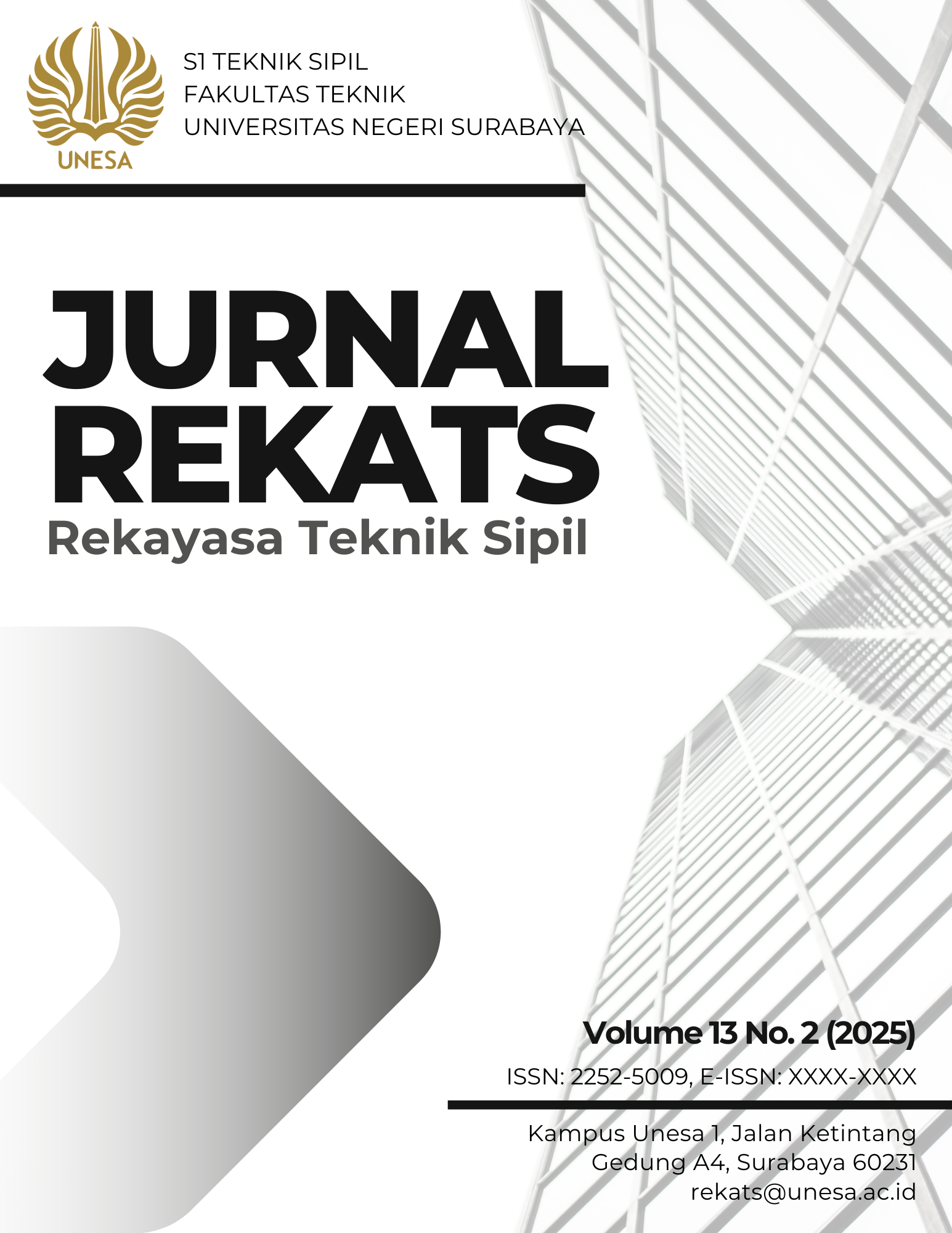UTILIZATION OF ALUMINIUM SLAG AS A FILLER IN HOT MIX ASPHALT (AC-BC) USING THE MARSHALL METHOD
DOI:
https://doi.org/10.26740/rekats.v13n02.p288-296Keywords:
AC-BC, Aluminium Slag, Filler, Marshall parameterAbstract
The road is an important part of the distribution process, as the land route plays a role in enhancing comfort and safety for those involved in the distribution process. The availability of roads is crucial for the mobility of the community, and therefore, high-quality road pavement materials are necessary. Substitution of filler material is one of the efforts that can be applied in road pavement. Filler material is a component with very fine granular texture that serves to fill the air voids in the asphalt mixture, thereby improving the density of the mixture. The selection of filler materials in asphalt mixtures should consider cost efficiency and must comply with the general specifications of Bina Marga (2018, Revision 2). In order to achieve this, Aluminum Slag is used as a filler material substitute, as aluminum slag is a by-product waste with very fine granules, making it suitable according to the specifications allowed for filler materials. The purpose of this study is to examine the impact of using Aluminum Slag as a filler in the mixture of Asphalt Concrete Binder Course (AC-BC) using the Marshall Method. This research demonstrates that the asphalt concrete binder course mixture with filler substitution using aluminum slag has an optimum asphalt content of 5.1%. However, other parameters such as VMA and VFA do not meet the requirements, while VIM does meet the standards.
Downloads
References
Adnany, I., & Risdianto, Y. (2019). Penggunaan Asbuton Lawele Granular Asphalt (Lga) Dan Buton Granular Asphalt (Bga) Pada Campuran Aspal Porus. Rekayasa Teknik Sipil, 2(1).
Akbar, S. J., & Wesli, W. (2016). Stabilitas Lapis Aspal Beton AC-WC Menggunakan Abu Sekam Padi. Teras Jurnal: Jurnal Teknik Sipil, 2(4).
Bukhari, R. A., & Eng, R. A. M. (2007). Rekayasa bahan dan tebal perkerasan jalan raya. Bidang Studi Teknik Transportasi Fakultas Teknik Unsyiah, Banda Aceh.
Departemen Permukiman dan Prasarana Wilayah. (2004). Asbuton campuran panas.
Direktorat Jenderal Bina Marga. (2019). Perancangan dan Pelaksanaan Campuran Beraspal Panas Bergradasi Menerus (Laston) Menggunakan Slag. Divisi 6 Kementerian Pekerjaan Umum dan Perumahan Rakyat.
Direktorat Jendral Bina Marga. (2018). Spesifikasi umum 2018. September.
Hardiyatmo, H. C. (2007). Pemeliharaan Jalan Raya. Gadjah Mada University Press, Yogyakarta.
Kamil, R. F. R., & RISDIANTO, Y. (2024). Pengaruh Penggunaan Agregat Beton Daur Ulang dan Asbuton BGA Dalam Pembuatan AC-WC. Ejournal UNESA, 1(1).
Lestari, D. R. E. (2022). Analisis Karakteristik Campuran Aspal Beton Lapis Aus (Ac-Wc) Dengan Menggunakan Kalsium Karbonat Sebagai Filler. Rekayasa Teknik Sipil, 10(2).
Putra, B. Y., & Risdianto, Y. (2023). PENGARUH ALUMINIUM SLAG SEBAGAI BAHAN SUBSTITUSI SEMEN PADA CAMPURAN BETON NORMAL. Ejournal UNESA, 2(1).
Sholekah, A. R. N. (2022). PEMANFAATAN ALUMINIUM SLAG DAN FLY ASH SEBAGAI BAHAN SUBSTITUSI SEMEN PADA CAMPURAN PEMBUATAN BETON RINGAN SELULER. Rekayasa Teknik Sipil, 10(3).
Suhardi, S., Pratomo, P., & Ali, H. (2016). Studi karakteristik Marshall pada campuran aspal dengan penambahan limbah botol plastik. Jurnal Rekayasa Sipil Dan Desain, 4(2), 127641.
Zuraidah, S. (2012). Pengaruh Penggunan Limbah Paving Sebagai Alternatif Agregat Kasar Untuk Beton. Jurnal Ilmiah Kern, 2(2), 69–72.
Downloads
Published
Issue
Section
 Abstract views: 54
,
Abstract views: 54
, PDF Downloads: 0
PDF Downloads: 0





